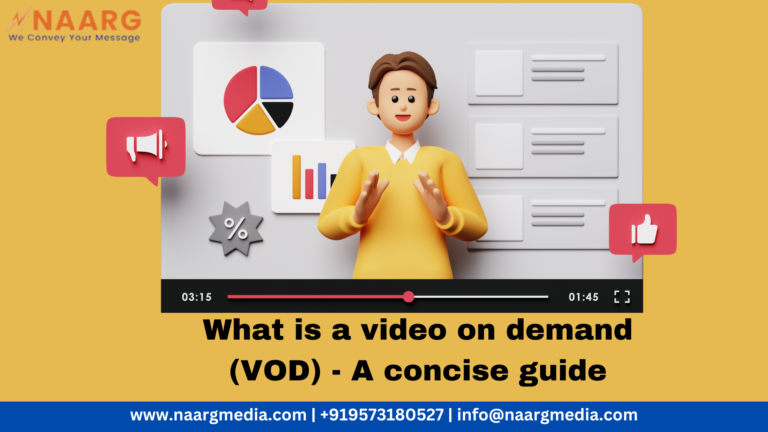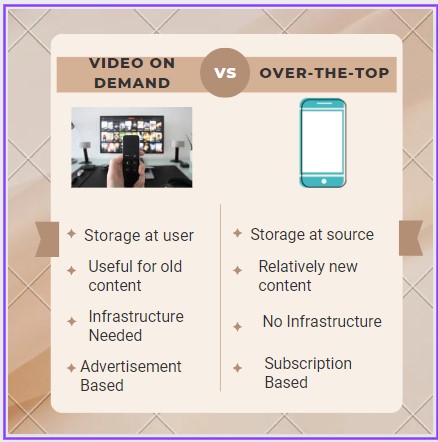With the rapid growth of the internet, there is an increasing demand to use various social media platforms like Facebook, Instagram, Twitter, WhatsApp and also Video On Demand. All the above-mentioned social media platforms are familiar but what is a Video On Demand? Video On Demand is a platform that allows users to watch their favourite content on television or a computer.
The market for Video On Demand is huge and its revenue is expected to show an annual growth rate (CAGR 2023-2027) of 9.71%, resulting in a projected market volume of US$230.90bn by 2027.
The number of VOD users is proliferating every year. Out of the data collected from 30,000 online service providers from 65 countries by the Global Marketing Survey, it is seen that almost 65% of customers watch VOD services all over the world.

What is a Video On Demand?
Video On Demand(VOD) is a media distribution system in which the users do not require video playback devices and there is no pre-scheduling of broadcasts like television. Video On Demand is a streaming service that requires an internet connection and the users can watch the content anytime and anywhere they want.
It is just the opposite of traditional broadcasting platforms where the users have to depend on pre-programmed content if they want to watch something. It is pre-recorded video content and the users can watch them on the internet anytime and anywhere they want. VOD services are provided by Amazon Prime and Apple TV. The first VOD business model was released in the early 1990s.
After many advancements and technological improvements, it is possible to stream videos via phone. VOD can be watched by any means like cable, TV or broadband. Many content creators make better content and add them to VOD platforms. Many VOD industries formulate a content strategy for good video content to be delivered to the audience.
VOD is the present and future of the broadcasting industry. In Television systems, TV shows are streamed through set-top boxes, cables, or smart devices like computers and mobile devices. But with VOD, users can download content permanently. It is advantageous because users can watch it while at work also.
Many VOD industries provide a good content strategy for good video content to be delivered to the audience. VOD offers popular content in a variety of domains including
- Entertainment
- Educational content (e-learning)
- Music
- Dance
- News
- Podcasts
- Employee training content
Some people get confused between VOD and OTT, while VOD is more adaptable to people’s preferences, and OTT has made broadcasting more affordable and efficient. To understand the differences between VOD and OTT, you can read our blog post ‘What is the difference between OTT and VOD’.
What are the examples of Video On Demand?
Examples of Video On Demand are:
1) Wistia
Wistia is used for marketing functions. It has many advanced features.
2) Vplayed
Vplayed offers content for every industry.
3) MuVi
It is a rich and video-flexible platform with a wide range of monetisation tools.
4) Uscreen
Uscreen is mainly focused on educational content. It is powered by Over The Top (OTT) Technology.
5) IBM Cloud Video
It is a professional video platform which provides corporate services.
How does Video On Demand work?
VOD works when a server sends the data or content to your video player. VOD is free in one model but earns money in another through advertisements, so instead of paying to see advertisements, they must see advertisements in AVOD(Advertisement Video On Demand). Ad revenue is determined by how much time you spend looking at them, whether they have appealing content, and the cost per view.
We can say that AVOD is ideal for the general public because there are no fees. On the other hand, advertising earnings vary by platform due to different algorithms.
Some platforms like Youtube also offer ad-free watching with a premium subscription, like the SVOD(Subscription Video On Demand) model. Few channels first post their content on TV and then upload it on VOD platforms. The VOD platform business is much more predictable.
In Video On Demand (VOD), to deliver or showcase video content, a video file is compressed and then transmitted over the internet, where it is to be delivered. The video file is converted to a readable format and then placed on servers. After reaching this stage, videos are loaded into the container, where subtitles, thumbnails, or any other information is added.
When VOD gets a request from a user, the video is compressed and then transmitted to the internet via the Content Delivery Network (CDN). When a video is received by our video player, it is decompressed and then decoded into a viewable format that the user can easily watch.
It is a content library, and users can watch video content on their own time and anywhere they want. Some platforms, like Youtube, also offer ad-free watching with a premium subscription, like the SVOD model. Few channels first post their content on TV and then upload it on VOD platforms. The VOD platform business is much more predictable.
3 types of VOD business models
1) Subscription Video on Demand (SVOD)
SVOD is a television streaming model based on subscription. Based on the contract, this model guarantees unlimited watching from the platform. For example, Netflix.
2) Transactional video on demand (TVOD)
There is a difference between SVOD and TVOD. SVOD is “open bar,” and TVOD is “cash bar.” The TVOD model charges the customer according to their content requirements, not like open account charges. It’s similar to how an online video store works, where users pay for videos or other content they want to watch.
3) Advertising Video On Demand (AVOD)
AVOD is a free audio and visual content model. AVOD is free; it doesn’t take any charges because AVOD is funded by advertising. When users watch advertisements, they pay for them. For example, YouTube or Spotify.
The Top 5 Advantages of VOD
1) Freedom to watch at any time
VOD allows users to watch any content at their leisure. Like a TV system, it does not force you to watch according to a schedule, it is independent of a timetable
2) Media controls in hand
Users have complete control over their VOD experience, with the ability to play, pause, resume, fast-forward, and rewind at any time.
3) Marketing launch
VOD is useful for launching products and publicising many events to a large audience.
4) Cheaper rates
Video on Demand is less expensive than cable. However, their monthly fees differ. The fees for various VOD services vary.
5) Video Editing
When it comes to streaming, once the content is edited, there is no way to change it, whereas, with video on demand, the provider makes the content editable at any time and many times.
The top three disadvantages of VOD
1) Unlike YouTube, VOD doesn’t have the advantage of storing the content to be viewed later.
2) The main disadvantage is that the service provider does not provide the customized content you want. They only stream the majority of viewers’ content. Increasing competition is also the case.
3) Some content might not be available at your location because of some broadcasting limitations.
How Do You Get Started With VOD Streaming?
Once you understand what type of content you want to make and publish, consider half the work is done. So below are a few procedures given:
- Choose a VOD service provider: Choose a professional video hosting solution. Find out about free hosting sites, too.
- Sign up: Sign up with any VOD platform. Upgrade to your preferred monthly plan.
- Website Template Selection.
- Upload video content.
- Monetize content.
- Go live.
In today’s day and age, it is really important to consider VOD over traditional broadcasting services. VOD helps in building an everlasting connection with potential audiences as well as it is a much better alternative for all. Businesses, content creators, as well as advertisers, can benefit from the services of VOD as it allows monetization of content and also lets advertisers target the right audience.
Want to know how you can make your platform more user friendly and reach a wider audience? Naarg has strategy experts who can support you in reaching a wider audience. Get in touch with us to know more details.


